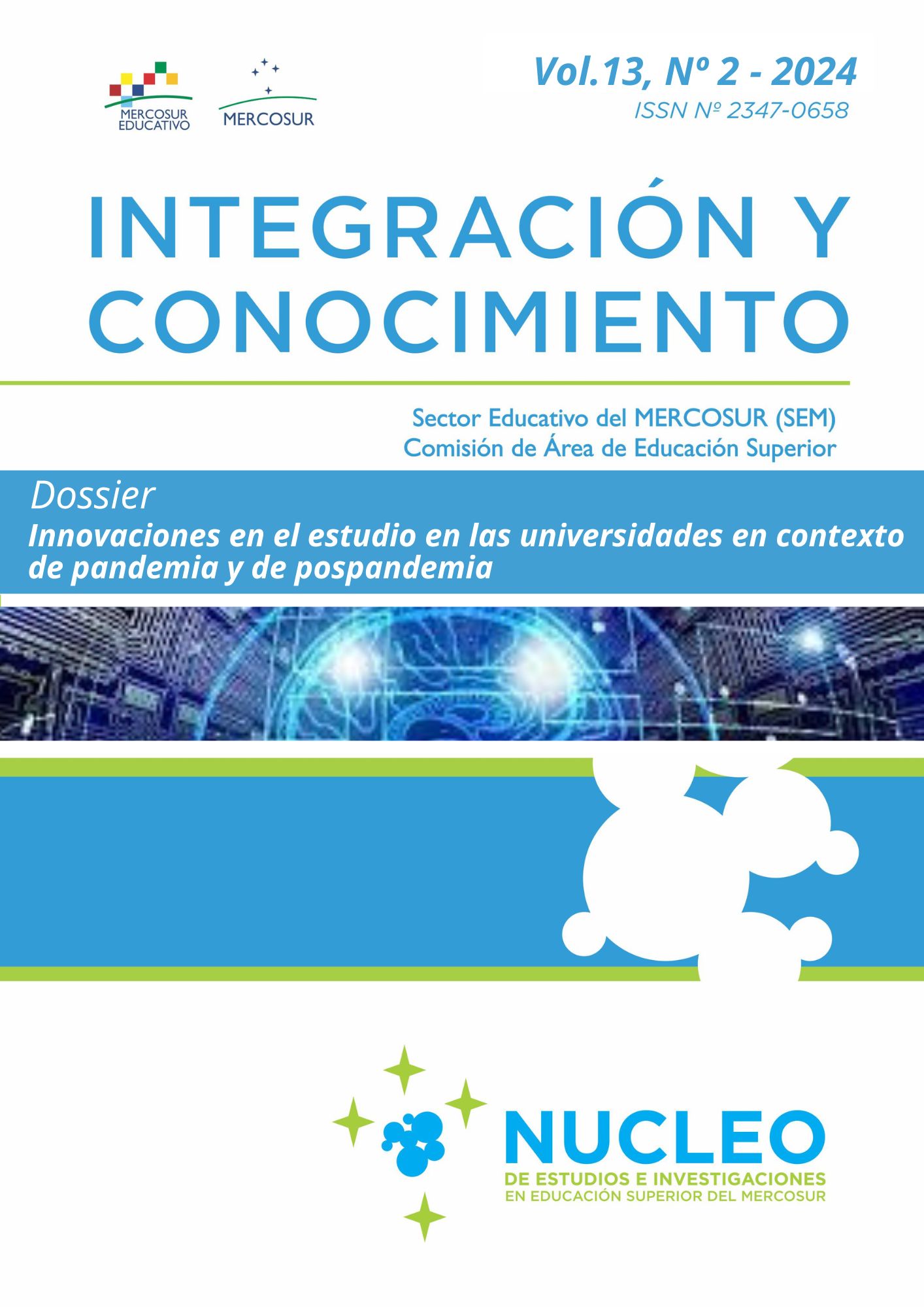PROSPECTIVE FOR UNIVERSITIES OF THE FUTURE FROM POST-PANDEMIC LEGACIES
Keywords:
University; Future; Multidiversity; PospandemicAbstract
The 2020/2021 pandemic confronted us with a difficult context, riddled with contradictions. Inequality in access to formal education was a tangible fact in numerous sectors of the population throughout the world, especially in countries with the greatest difficulties in their development. But the pandemic also inaugurated new ways of learning and teaching for many students and teachers, and in the case of higher education, it forcefully reinstated the founding principles of distance learning, providing opportunities for busy adults who could not access the studies in institutions with face-to-face modality. Convened by the Secretariat of University Policies, the National University of Patagonia San Juan Bosco -UNPSJB- together with eight other universities carried out a study about the actions developed from the emergency situation generated by pandemic, which forced the university system to adapt the pedagogical, scientific and social continuity of its academic offer, its research, its relationship with society and its forms of institutional management. The working group was made up of representatives of all faculties, coordinated by the Permanent Institutional Evaluation Program. In this work, several of the opinions and experiences shared by professors, students and researchers of the UNPSJB during the pandemic stage are recovered, in order to recognize and understand the educational processes that have arisen in an institution that, from the emergence of these phenomena, has changed in some of its practices and will surely continue to transform.
Downloads
References
Baricco, A. (2019). The Game. Barcelona, España: Anagrama.
Basabe, L. y Cols, E. (2007). La enseñanza, pp. 125-161. En Camilloni, A., El saber didáctico. Buenos Aires, Argentina: Paidós.
Becerra Artieda, F., Bustos, D., Denadei, M, Garriga, M., Hayes, L., Irusta, J. M., Mayorga, V., Muriete, R., Ortega, M.T., Perales, S., Quilodrán, R. y Suárez, S. (2022). La Universidad Nacional de la Patagonia San Juan Bosco ante la pandemia COVID-19: Continuidad pedagógica y vínculo con la comunidad. En Brumat, M.R. (coord.) Nuestras universidades públicas argentinas frente a la pandemia COVID-19, pp.107-143. Comodoro Rivadavia, Argentina: Editorial EDUPA
Berardi, F. (2019). Futurabilidad. La era de la impotencia y el horizonte de la posibilidad. Buenos Aires, Argentina: Caja Negra.
Buckingham, D. (2008). Más allá de las tecnologías. Buenos Aires, Argentina: Manantial.
Cabero Almenara, J. y Lorente Cejudo, M. (2020). Covid-19: transformación radical de la digitalización en las instituciones universitarias. Revista Campus virtuales, 9(2), pp. 25-34. Recuperado de http://www.uajournals.com/ojs/index.php/campusvirtuales/article
/view/713/410
Camilloni, A. (2001). Modalidades y proyectos de cambio curricular. En: Aportes para un cambio curricular en Argentina 2001. Universidad de Buenos Aires, OPS/OMS. Buenos Aires, Argentina: UBA. Recuperado de https://www.fmed.edu.uy/sites/default/files/claustro/
documentos/modalidades%20y%20proyectos%20de%20cambio%20curricular%20A%20Camilloni.pdf
Castells, M. (2000). La era de la información. Economía, Sociedad y Cultura. Vol.2, El poder de la identidad. Madrid, España: Alianza
Coicaud, S. (2019). Potencialidades didácticas de la inteligencia artificial. Videojuegos, realidad extendida, robótica y plataformas. Mediaciones tecnológicas para una enseñanza disruptiva, Buenos Aires, Argentina: Novedades educativas.
Doueihi, M. (2010). La gran conversión digital. Buenos Aires, Argentina: Fondo de Cultura Económica.
Dussel, I. (2022). ¿Estamos ante el fin de la escuela? Transformaciones tecnológicas y pedagógicas en la pospandemia. Revista del IICE, 51, pp. 31-48.
Etkin, J. (2007). Capital social y valores en la organización sustentable. Madrid, España: Granica.
González Fernández, M. O. (2021). La capacitación docente para una educación remota de emergencia por la pandemia de la COVID-19. Revista Tecnología, Ciencia y Educación, 19, pp. 81–102.
Hodges, C., Moore, S., Lockee, B., Trust, T., y Bond, A. (2020). The difference between emergency remote teaching and online learning, p. 3. EDUCAUSE Review. Recuperado de https://er.educause.edu/articles/2020/3/the-difference-between-emergency-remote-teaching-and-online-learning
Maggio, M. (2012). Enriquecer la Enseñanza. Los ambientes con alta disposición tecnológica como oportunidad. Buenos Aires, Argentina: Paidós.
Miranda, E. (2020). Políticas de educación superior en Argentina. Entre la COVID-19 y la deuda externa heredada. Revista Universidades, 85, p. 208. UDUAL. Recuperado de DOI:https://doi.org/10.36888/udual.universidades.2020.85.280
Pardo Kuklinski, H. (2023). Los futuros inevitables de la universidad. Ideas para gestores hacia la consolidación híbrida. Medellín, Colombia: Escuela de Educación. UPB Virtual.
Pedraza Flores, R. (2021). Estudios del futuro para comprender la posibilidad de la universidad ubicua, Revista Interdisciplina, 9 (25), p. 223, Ciudad de México, México. Recuperado de https://doi.org/10.22201/ceiich.24485705e.2021.25.79974
Pérez Lindo, A. (2004). Gestión del conocimiento en la universidad. Trabajo presentado en el IV Encuentro Nacional y I Latinoamericano, La Universidad como Objeto de Investigación, Universidad Nacional de Tucumán, San Miguel de Tucumán., Argentina.
Pulido, A. (2009). El futuro de la universidad. Un tema para el debate dentro y fuera de las universidades. Madrid, España: Delta Publicaciones Universitarias
Williamson, B. (2018). Big data en educación. El futuro digital del aprendizaje, la política y la práctica. Madrid, España: Morata.
Downloads
Published
Issue
Section
License
Copyright (c) 2024 Integración y Conocimiento

This work is licensed under a Creative Commons Attribution-NonCommercial-ShareAlike 4.0 International License.
Authors who have publications with this journal accept the following terms:
a. Authors shall retain their copyright and guarantee the journal the right of first publication of their work, which shall simultaneously be subject to the Creative Commons License of Recognition which allows third parties to share the work as long as its author is indicated and its first publication is this journal.
b. Authors may adopt other non-exclusive licensing agreements for the distribution of the published version of the work (e.g., depositing it in an institutional telematic archive or publishing it in a monographic volume) provided that the initial publication in this journal is indicated.
c. Authors are allowed and encouraged to disseminate their work via the Internet (e.g. in institutional telematic archives or on their website) after publication of the article, which may lead to interesting exchanges and increased citations of the published work. (See The Effect of Open Access).



